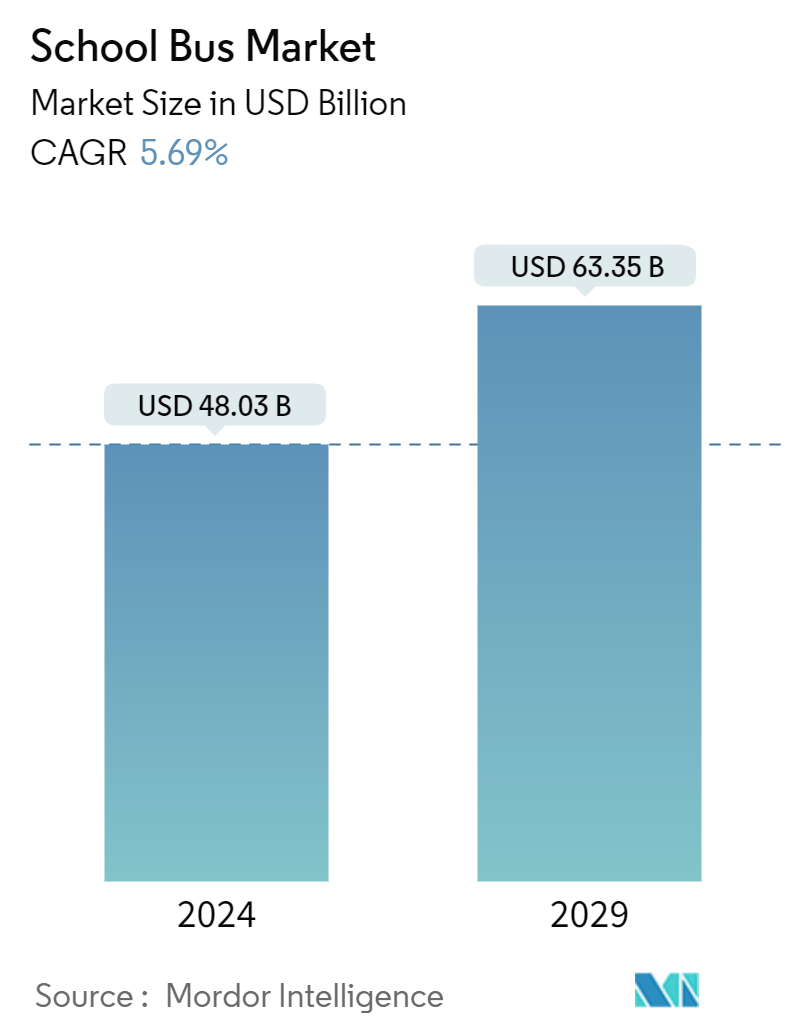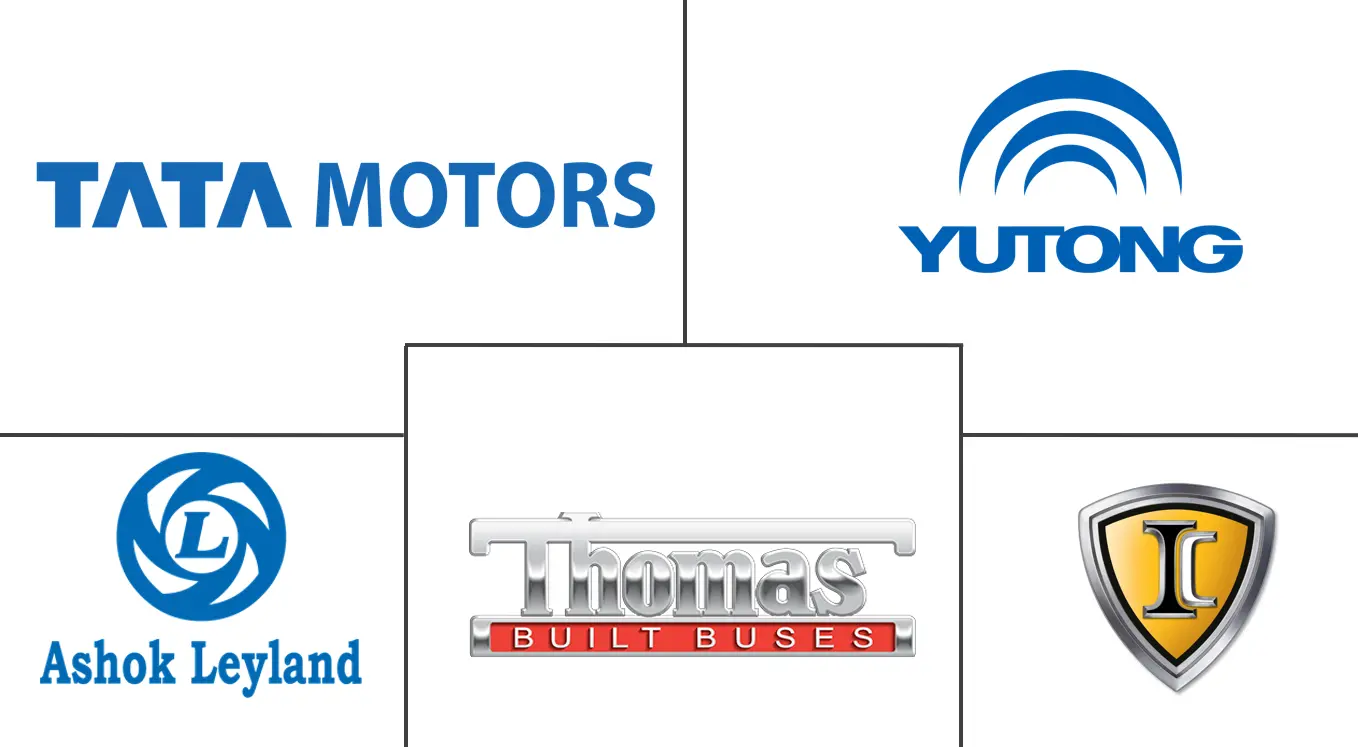Market Size of School Bus Industry

| Study Period | 2019-2029 |
| Market Size (2024) | USD 48.03 Billion |
| Market Size (2029) | USD 63.35 Billion |
| CAGR (2024 - 2029) | 5.69 % |
| Fastest Growing Market | Asia Pacific |
| Largest Market | North America |
Major Players
*Disclaimer: Major Players sorted in no particular order |
School Bus Market Analysis
The School Bus Market size is estimated at USD 48.03 billion in 2024, and is expected to reach USD 63.35 billion by 2029, growing at a CAGR of 5.69% during the forecast period (2024-2029).
The school bus market is transforming, driven by multiple factors reshaping student transportation. Growing concerns for student safety are fuelling the demand for technologically advanced buses. Additionally, government initiatives worldwide supporting education infrastructure are propelling growth. In 2023, the regional market share was dominated by North America, followed by Europe, Asia-Pacific, Latin America, and the Middle-East and Africa.
Furthermore, rapid urbanization and population growth are key drivers necessitating innovative solutions for route optimization and congestion reduction. The growing demand for electric school buses, driven by a global shift toward sustainability, presents growth opportunities for the market. There has also been a surge in interest in zero-emission, electric-powered buses. Integrating advanced technologies, including artificial intelligence for route optimization and IoT-enabled maintenance monitoring, presents a significant opportunity for market players to differentiate their offerings.
Moreover, the adoption of fleet management solutions, encompassing real-time tracking, maintenance scheduling, and data analytics, is emerging as a key trend. This allows educational institutions to optimize operations, enhance safety, and reduce overall costs. However, budget constraints in educational institutions, especially in developing regions, pose challenges for market expansion.
Collaboration between school bus manufacturers, technology providers, and educational institutions fosters innovation. These partnerships are essential in addressing the market's diverse needs and providing comprehensive, integrated solutions.
Despite all the challenges, the school bus market is expected to continue its growth trajectory in the coming years.
School Bus Industry Segmentation
The school bus is a type of bus that is used to ferry children to and fro from school or activities related to school. School buses may be owned by the school or leased by bus providers. School buses are built with specific seating arrangements and luggage-carrying shelves that are designed for children.
The school bus market is segmented by propulsion type, capacity design, and geography. By propulsion type, the market is segmented as internal combustion engine (IC), Compressed natural gas (CNG)/liquified natural gas (LNG), and electric and hybrid. By capacity design, the market is segmented as Type A, Type B, Type C, and Type D. By geography, the market is segmented as North America, Europe, Asia-Pacific, and the Rest of the World. The report offers the market size and forecasts in terms of value (in USD) for all the segments mentioned above.
| By Propulsion Type | |
| Internal Combustion Engine (ICE) | |
| Compressed Natural Gas (CNG)/ Liquified Natural Gas (LNG) | |
| Electric and Hybrid |
| By Capacity Design Type | |
| Type A | |
| Type B | |
| Type C | |
| Type D |
| By Geography | ||||||||
| ||||||||
| ||||||||
| ||||||||
|
School Bus Market Size Summary
The school bus market is undergoing significant transformation, driven by increasing concerns for student safety and the demand for technologically advanced transportation solutions. Government initiatives worldwide are further propelling the market, with a strong focus on enhancing education infrastructure. North America currently leads the regional market, followed by Europe, Asia-Pacific, Latin America, and the Middle East and Africa. Rapid urbanization and population growth are prompting innovative approaches to route optimization and congestion reduction. The shift towards sustainability is fostering a growing demand for electric school buses, presenting substantial growth opportunities. The integration of advanced technologies, such as artificial intelligence and IoT-enabled maintenance monitoring, is enabling market players to differentiate their offerings and enhance operational efficiency.
The electrification of school buses is gaining momentum, supported by government incentives and a global push towards zero-emission vehicles. This trend is particularly evident in regions like North America and Europe, where significant investments and policy announcements are driving the adoption of electric buses. The market is moderately consolidated, with major players like Thomas Built Buses, Yutong Bus Co., and Tata Motors Ltd. actively engaging in strategic collaborations, mergers, and product development to strengthen their market positions. The presence of large bus manufacturers and rising disposable incomes in markets like China and India are contributing to the market's expansion. Despite challenges such as budget constraints in educational institutions, the school bus market is poised for continued growth, with electric buses expected to play a pivotal role in shaping its future.
School Bus Market Size - Table of Contents
-
1. MARKET DYNAMICS
-
1.1 Market Drivers
-
1.1.1 Government Initiatives Worldwide Supporting Education Infrastructure are Propelling Growth
-
-
1.2 Market Restraints
-
1.2.1 Stringent Regulatory Compliance Standards Related to Emissions and Safety Present Hurdles
-
-
1.3 Industry Attractiveness - Porter's Five Forces Analysis
-
1.3.1 Threat of New Entrants
-
1.3.2 Bargaining Power of Buyers/Consumers
-
1.3.3 Bargaining Power of Suppliers
-
1.3.4 Threat of Substitute Products
-
1.3.5 Intensity of Competitive Rivalry
-
-
-
2. MARKET SEGMENTATION (VALUE IN USD BILLION)
-
2.1 By Propulsion Type
-
2.1.1 Internal Combustion Engine (ICE)
-
2.1.2 Compressed Natural Gas (CNG)/ Liquified Natural Gas (LNG)
-
2.1.3 Electric and Hybrid
-
-
2.2 By Capacity Design Type
-
2.2.1 Type A
-
2.2.2 Type B
-
2.2.3 Type C
-
2.2.4 Type D
-
-
2.3 By Geography
-
2.3.1 North America
-
2.3.1.1 United States
-
2.3.1.2 Canada
-
2.3.1.3 Mexico
-
2.3.1.4 Rest of North America
-
-
2.3.2 Europe
-
2.3.2.1 Germany
-
2.3.2.2 United Kingdom
-
2.3.2.3 France
-
2.3.2.4 Russia
-
2.3.2.5 Spain
-
2.3.2.6 Rest of Europe
-
-
2.3.3 Asia-Pacific
-
2.3.3.1 China
-
2.3.3.2 India
-
2.3.3.3 Japan
-
2.3.3.4 South Korea
-
2.3.3.5 Rest of Asia-Pacific
-
-
2.3.4 Rest of the World
-
2.3.4.1 South America
-
2.3.4.2 Middle-East and Africa
-
-
-
School Bus Market Size FAQs
How big is the School Bus Market?
The School Bus Market size is expected to reach USD 48.03 billion in 2024 and grow at a CAGR of 5.69% to reach USD 63.35 billion by 2029.
What is the current School Bus Market size?
In 2024, the School Bus Market size is expected to reach USD 48.03 billion.

